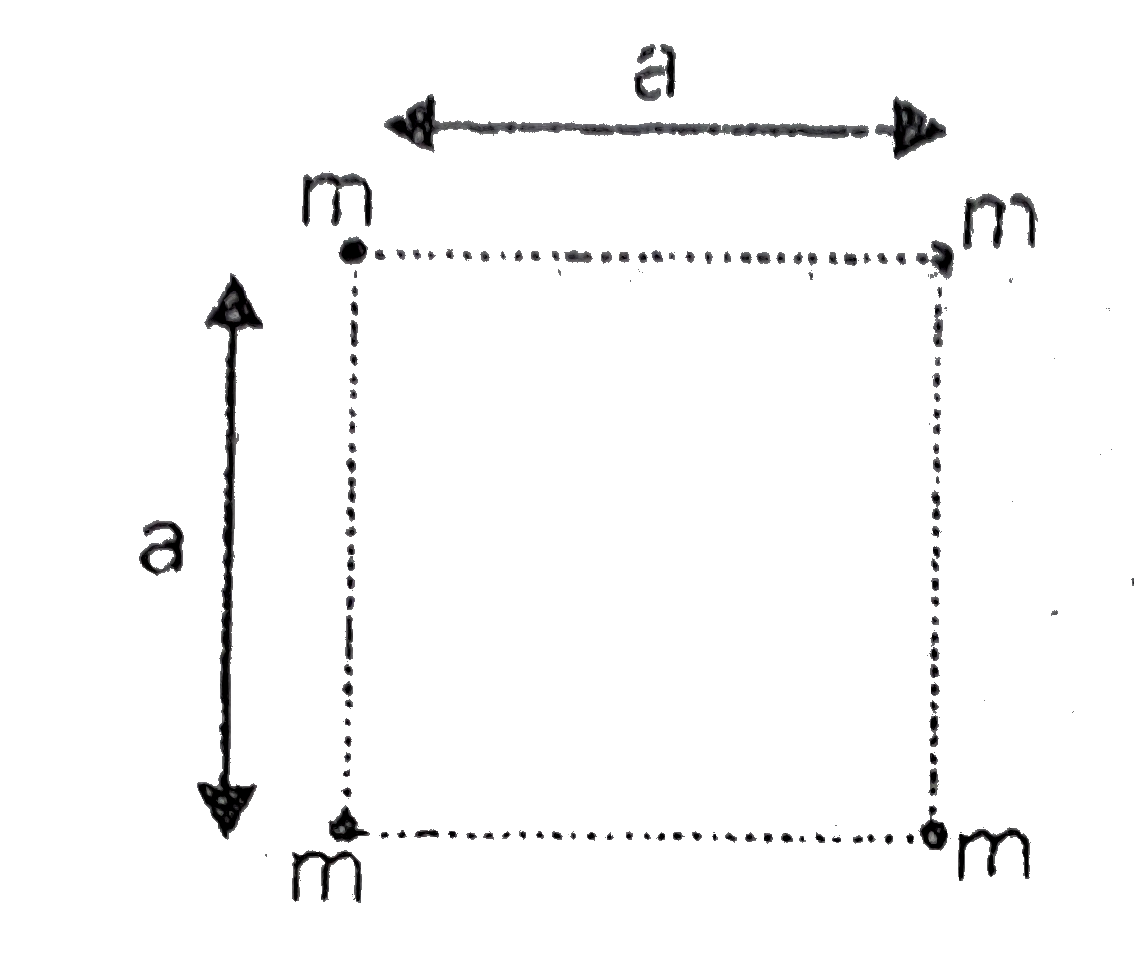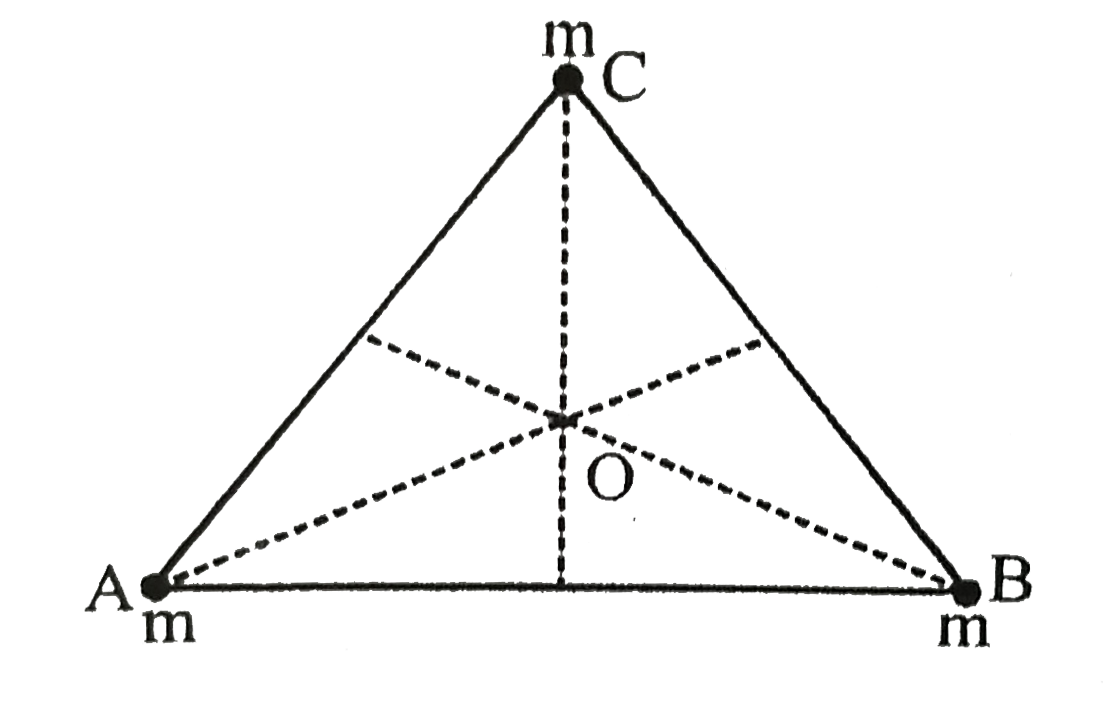Four particles having masses, m, 2m, 3m, and 4m are placed at the four corners of a square of edge a. Find the gravitational force acting on a particle of mass m placed at the center.
The correct Answer is:A, B, D
To find the gravitational force acting on a particle of mass m placed at the center of a square with four particles of masses m,2m,3m, and 4m at its corners, we can follow these steps:
Step 1: Identify the positions and distances
The four particles are located at the corners of a square of edge length a. The center of the square is at a distance of a√2 from each corner (using the Pythagorean theorem).
Step 2: Calculate the gravitational force from each corner mass
The gravitational force F between two masses is given by the formula:
F=G⋅m1⋅m2r2
where G is the gravitational constant, m1 and m2 are the masses, and r is the distance between them.
1. From mass 4m at corner A:
FA=G⋅m⋅4m(a√2)2=4Gm2a22=8Gm2a2
2. From mass 3m at corner B:
FB=G⋅m⋅3m(a√2)2=3Gm2a22=6Gm2a2
3. From mass 2m at corner C:
FC=G⋅m⋅2m(a√2)2=2Gm2a22=4Gm2a2
4. From mass m at corner D:
FD=G⋅m⋅m(a√2)2=Gm2a22=2Gm2a2
Step 3: Determine the direction of the forces
Each force acts along the line connecting the center of the square to the respective corner. The forces from opposite corners will have components that can be resolved into x and y directions.
Step 4: Calculate the net force components
Since the square is symmetric, we can sum the x and y components separately.
1. X-components:
- FA and FC will have components in the positive x-direction.
- FB and FD will have components in the negative x-direction.
2. Y-components:
- FA and FB will have components in the positive y-direction.
- FC and FD will have components in the negative y-direction.
Step 5: Calculate the resultant force
The total gravitational force acting on the mass m at the center is the vector sum of all the forces. Since the forces from opposite corners cancel each other out due to symmetry, we can calculate the resultant force as:
Fnet=FA+FB+FC+FD
Substituting the values:
Fnet=(8Gm2a2+6Gm2a2+4Gm2a2+2Gm2a2)=20Gm2a2
Final Result
The total gravitational force acting on the particle of mass m at the center of the square is:
Fnet=20Gm2a2
The four particles are located at the corners of a square of edge length a. The center of the square is at a distance of a√2 from each corner (using the Pythagorean theorem).
The gravitational force F between two masses is given by the formula:
F=G⋅m1⋅m2r2
where G is the gravitational constant, m1 and m2 are the masses, and r is the distance between them.
FA=G⋅m⋅4m(a√2)2=4Gm2a22=8Gm2a2
FB=G⋅m⋅3m(a√2)2=3Gm2a22=6Gm2a2
FC=G⋅m⋅2m(a√2)2=2Gm2a22=4Gm2a2
FD=G⋅m⋅m(a√2)2=Gm2a22=2Gm2a2
Each force acts along the line connecting the center of the square to the respective corner. The forces from opposite corners will have components that can be resolved into x and y directions.
Since the square is symmetric, we can sum the x and y components separately.
- FA and FC will have components in the positive x-direction.
- FB and FD will have components in the negative x-direction.
- FA and FB will have components in the positive y-direction.
- FC and FD will have components in the negative y-direction.
The total gravitational force acting on the mass m at the center is the vector sum of all the forces. Since the forces from opposite corners cancel each other out due to symmetry, we can calculate the resultant force as:
Fnet=FA+FB+FC+FD
Substituting the values:
Fnet=(8Gm2a2+6Gm2a2+4Gm2a2+2Gm2a2)=20Gm2a2
The total gravitational force acting on the particle of mass m at the center of the square is:
Fnet=20Gm2a2
Topper's Solved these Questions
- BOOK - HC VERMA ENGLISHCHAPTER - GRAVITATIONEXERCISE - Question for short Answers18videos
GRAVITATION
- BOOK - HC VERMA ENGLISHCHAPTER - GRAVITATIONEXERCISE - Objective -26videos
GRAVITATION
- BOOK - HC VERMA ENGLISHCHAPTER - FRICTIONEXERCISE - Questions for short Answer11videos
FRICTION
- BOOK - HC VERMA ENGLISHCHAPTER - HEAT AND TEMPERATUREEXERCISE - Objective 26videos
HEAT AND TEMPERATURE
Similar Questions
Four particles having masses, m, 2m, 3m, and 4m are placed at the four corners of a square of edge a. Find the gravitational force acting on a particle of mass m placed at the centre.
View SolutionFour particles having masses, m, 2m, 3m, and 4m are placed at the four corners of a square of edge a. Find the gravitational force acting on a particle of mass m placed at the centre.
View SolutionIf four different masses m1,m2,m3 and m4 are placed at the four corners of a square of side a, the resultant gravitational force on a mass m kept at the centre is
View SolutionFour particles of masses m,2m,3m,4m are placed at corners of a square of side 'a' as shown in fig. Find out coordinateds of centre of mass.
View SolutionFour particles of masses 1kg, 2kg, 3kg and 4kg are placed at the four vertices A, B, C and D of a square of side 1m. Find the position of centre of mass of the particles.
View SolutionFour particles of masses 1kg, 2kg, 3kg and 4kg are placed at the four vertices A, B, C and D of a square of side 1m. Find the position of centre of mass of the particles. Assume that D is situated at the origin.
View SolutionFour point masses each of mass 'm' are placed on the corner of square of side 'a' Calculate magnitude of gravitational force experienced each particle
 .View Solution
.View SolutionFour particles each of mass m are kept at the four vertices of a square of side 'a' . Find gravitational potential energy of this system.
View SolutionFour particles of masses 1kg, 2kg, 3kg and 4kg are placed at the four vertices A,B,C and D of a square of side 1m. Find square of distance of their centre of mass from A.
View SolutionThree identical particles each of mass m are placed at the vertices of an equilateral triangle of side a. Fing the force exerted by this system on a particle P of mass m placed at the

(a) the mid point of a side
(b) centre of the triangleView Solution

